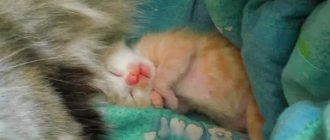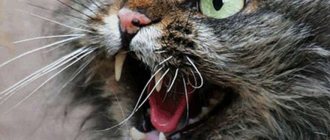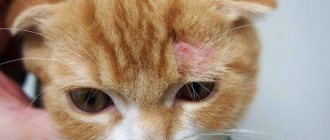Today our story is about the behavior of cats before giving birth.
An important point that can lead to both unforeseen situations and various complications. To better prepare for the birth of your pet, you should understand how the cat behaves before lambing and how its behavior changes. Cats bear kittens for 60-65 days, sometimes up to seventy days. It is good if the owners take their pregnant pet to the veterinarian. There, already on the 26th day, the presence of kittens in the womb will be determined by palpation. If you do an ultrasound, both the size of the litter and congenital pathologies or deformities will be established.
At what age do cats give birth?
From 7 months, the cat begins to be interested in the opposite sex and becomes sexually mature. If you want to get healthy offspring, veterinarians advise breeding the animal during its second heat.
Cats can give birth until old age, but pet owners should stop their pet’s sex life in time so that the quality of the offspring and the health of the cat are not affected. After all, when abusing a cat’s ability to give birth, people often think only about their own wallet. Thus, to avoid problems, veterinarians recommend spaying or neutering an animal at the age of 6-7 years.
Cat behavior, problems and causes
Among the pets there are both silent and talkative ones. Some of them isolate themselves with their problem and lie quietly in a corner, while the owner puzzles over what could have happened. And others loudly report an uncomfortable state, however, this situation also drives people crazy.
The main thing is to know that a cat screams for a reason. It is important to detect it and help your pet cope with it. Even if it’s just a whim, you need to evaluate why she’s capricious and show maximum attention.
How to tell if your cat is pregnant
Signs of pregnancy in a cat can be observed 3 weeks after conception. Some people who let their cats go outside can track this period on a calendar (as a rule, the cat does not spend the night at home and does not appear in front of its owners for 3-4 days). Those owners who specifically breed a cat with a cat can also calculate whether the cat is pregnant. We will tell you further how many months you will have to wait for a replenishment. The most difficult thing to predict pregnancy is for those owners whose cat walks outside on its own.
You can determine that a cat is pregnant by the following signs:
- the cat’s appetite has changed: it happens that favorite treats remain untouched, and any food consumption ends in vomiting and severe weakness;
- changes in behavior: the cat sleeps more than before and moves less (if the cat was previously wild and could bite, now it should be affectionate and calm);
- swelling of the mammary glands and redness of the nipples;
- rounding of the abdomen.
Mating cats
Having noticed the cat, the cat begins expressive play. The cat's actions are focused on luring the cat, she seems to persuade him, yielding to him, but then runs away. Thus, the cat flirts with the cat. Then the cat grabs the cat by the scruff of the neck, jumps up and climbs into it.
The cat lets out a piercing scream and breaks away. She throws herself on the floor and starts rolling on the floor again. For some period of time the cat will not let the cat near her, but after a couple of minutes she will flirt with the cat again. Mating is repeated again. During the mating period, eggs are released from the ovaries of a cat.
The cat's sperm enters the cat's uterus, where it remains viable for about 4 days. The ability of the egg to fertilize is stored for up to 1.5 days.
Cat pregnancy
Pregnancy in a cat lasts 65-70 days (9-10 weeks, or 2.5 months). If you are unable to independently determine whether pregnancy has occurred and how many months the cat will still bear kittens, seek advice from a specialist.
In the last week before giving birth, the cat begins to choose a place for itself and put its “stuff” there. Owners are advised to think about creating favorable conditions for the animal from the very beginning of pregnancy: choose a spacious box, put diapers or cloth rags on the bottom. The expectant mother should get used to the nest that you built for her.
The duration of pregnancy in cats may vary depending on the number of kittens, the age of the animal and the conditions in which the pet is in the last month of pregnancy. So, if the cat is stressed, then the gestation period may be delayed, and if the pregnancy is multiple, then labor may begin prematurely, in this regard, it is extremely important to know how to understand that a cat is beginning to give birth.
If the due date is postponed a week earlier or a week later, you should not panic, as this is quite natural.
Problems may arise if labor begins earlier than 60 days (the kitten will be born weak and unable to live) or later than 80 days (there is a possibility that the offspring will develop pathologies).
Signs of the beginning of labor in a cat can be determined a day before, or even 1-2 hours before the start of the process.
Medicines, instruments and consumables
Preparing for childbirth includes providing your pet with everything necessary for childbirth:
sterile gauze wipes, cotton wool and bandages;
absorbent diapers, not scented;
a lot of rags, ironed and put in a bag (you can cut an old sheet, cutting off the protruding threads);
sterile surgical gloves, two to three pairs;
a waffle towel or a piece of fabric with similar properties (if you suddenly need to give the kitten a massage);
catgut or surgical thread for tying the umbilical cords, pieces 10-15 cm long (as soon as the first signs of labor appear, the threads should be placed in a glass of alcohol for disinfection);
small scissors with rounded tips;
children's syringe for suctioning liquid from the nose and mouth;
scales, watch, pen and notepad. A meticulously filled birth log makes the veterinarian’s work easier (it is impossible to remember all the information, even experienced breeders write down);
hydrogen peroxide, brilliant green, potassium permanganate, sterile Vaseline or boiled Vaseline oil at room temperature;
oxytocin, glucose, sulfocamphocaine, calcium gluconate, vitamin B12. All in injection ampoules, use strictly after consultation with a veterinarian;
disposable insulin and regular syringes;
ammonia, cognac (to revive a weak kitten or an impressionable owner);
bags for used materials.
“Only cats are born easily,” says a well-known proverb. And indeed: in most cases, the natural process of giving birth to kittens is relatively easy and without outside intervention. However, this does not mean at all that you need to leave things to chance - during childbirth, your pet will greatly benefit from the help of an attentive owner, who should also know what to do in case of complications. So, how to deliver a cat?
Pregnancy in cats lasts on average 2 months (63 days). The normal duration of this period is considered to be 59-70 days.
In order for the birth to take place calmly and safely, the owner of the furry mother needs to take some measures in advance:
- Arrange with your veterinarian to make a home visit if necessary. Be sure to check with him whether it is possible to receive consultations by phone.
- If the animal has health problems, consult a specialist: it may be better for her to give birth in a veterinary clinic.
- Before giving birth, arrange a place for your pet and prepare everything you need (more on this below).
- In late pregnancy, do not allow your cat to jump on high objects - with a large belly, she becomes clumsy and can easily fall.
Stages of pregnancy
Cat pregnancy is usually divided into several stages:
- Stage 1 – the first three weeks of pregnancy. The mammary glands and genitals become swollen, cats begin to sleep more, there is no appetite as such, and activity is zero. The animal requires attention, sleeps with the owner, clinging to him, the animal may have a gag reflex when eating, or an increase in the size of the uterus upon palpation.
- Stage 2 – from the fourth to the sixth week. The kittens begin to become active and move. The expectant mother has a good appetite and gets plenty of rest. A cat may refuse its favorite food and prefer dairy products. If your cat is vomiting, it is best to take it to the vet.
- Stage 3 – six to nine weeks. Kittens move actively, this is best noticeable when the animal is sleeping. The abdomen is large, the mammary glands are enlarged, colostrum may be released. Hair falls out on the cat's belly, internal organs are displaced due to the large size of the kittens. The cat moves carefully, tries not to jump too much, and sleeps on its side. To prevent the pet from gaining excess weight, it is transferred to fractional meals (4-5 times a day).
Caring for cats and kittens after birth
The box should be cleaned and soiled diapers replaced with clean ones. Place the box with the family in a quiet place. Observe behavior: if there was a simple birth, without complications, then the mother is calm, focused on licking and feeding the children. To eliminate stress and cessation of lactation, you will have to temporarily limit the visits of guests.
Further care for the cat that has given birth comes down to ensuring cleanliness and nutrition. It is recommended to keep the tray and bowls close to the box so that the mother is close to the offspring. Feed 5 times a day, give vitamins for newborn cats.
How does the stomach change during pregnancy?
20 days after conception, the nipples change color. If you have already given birth before, your nipples may change slightly. The belly grows as the kittens grow and develop. But if 1-2 kittens develop and grow in the mother’s belly, then the belly may be small until the last weeks.
Before giving birth, a cat's stomach drops. As a rule, this happens within 7 days, and the stomach takes a pear shape. This is due to the fact that the kittens are already preparing for birth, taking the necessary position for this.
It should also be noted that the expectant mother’s stomach is not soft, but hard, which means that the body is ready for labor and childbirth.
What happens to the animal
In order to know when your pet will give birth to kittens, you need to closely monitor her, especially in the last weeks of pregnancy. But the main signs appear about a few days before this process. Severe pain begins in the uterine area, and such pain can also occur if labor begins a little earlier or if a rejection process has occurred, that is, a miscarriage. When the animal’s pregnancy proceeded normally, the birth process will go very quickly, without complications. In order to help your pet give birth normally, you need to know how cats behave before giving birth and what happens to them at this moment.
The very first signs are a mucus plug, it comes out first, but it is very difficult to see, since this happens when the cat went to the toilet. She also begins to lick herself very often, but many also do not pay attention to such a trifle, since animals lick themselves quite often. Well, the last sign is contractions. They can be noticed without palpation. And then somewhere, half an hour later, the first kitten appears. Also, before the babies are born, the expectant mother may develop a fever and begin vomiting. At this time, the body is experiencing a strong emotional shock, so do not worry, as this is a natural process.
What to prepare before giving birth to a cat
For comfortable bearing of kittens and their comfortable maintenance in the first weeks after birth, the cat should create all the conditions and prepare a cozy nest. It is best to place this place in silence, away from a noisy room and children, otherwise the cat will look for another place for itself and the kittens.
It is also necessary to organize a spacious maternity area in which the mother and kittens will stay for about two months.
Other signs associated with cats
Pets are often associated with guests. It is believed that cold paws foretell the arrival of an unpleasant visitor. If the cat shits itself, it means a person will come into the house and offend the owners. The cat ran in and wrote - expect a visit from an ill-wisher. Washing too often means distant relatives from the outback will come. A cat on a window or windowsill means a close and long-awaited guest will arrive.
Many folk superstitions are associated with the road. If a cat crosses the road before a long journey, it means the path will be difficult. Hitting a cat with a car is a very bad omen. If you kill an animal, bury it and ask that no evil fate befall you. Pussy gave birth before the road - it’s better not to go anywhere. A dead kitty is found, and the traveler is in mortal danger. The missing cat returned before the trip, which means the journey will be easy, successful, and the one leaving will return home safely.
Sailors left many signs associated with their tailed friends. If your cat follows you before fishing, you can safely take him with you. The catch will be plentiful. If a dead cat gets caught in the net, you need to immediately swim to the shore, the ship will face misfortune. If a cat lifts its hind legs up and sneezes, there will be a storm at sea. To see a cat that accidentally got on a ship, unfortunately during the voyage. If she is huddled in a corner in a cabin, death awaits its resident, she ends up on her back or throws herself on her leg, the person at sea will get sick.
You can choose to trust or not in cat omens. But the tradition of guessing the future by the behavior of cats has taken root. Therefore, it seems to me that it is worth paying tribute to her and, just in case, listening to folk wisdom. After all, if a person is forewarned, he is forearmed. And picking up a stray kitten is far from a sign of superstition, but ordinary human mercy.
What is not recommended to do before labor begins
To ensure a smooth birth, pay attention to the list of things you should not do:
- irritate the woman in labor with loud screams, numerous guests, parties;
- actively feel the stomach, as you may accidentally injure the cat or kittens;
- Give your cat medications on your own without consulting a specialist;
- ignore vomiting, discharge and changes in the behavior of the pregnant woman;
- allow your cat to come into contact with animals whose health status you do not know;
- allowing you to sleep in a dirty place, handling the animal with dirty hands, frequently changing the linen in the cat’s sleeping area;
- use chemicals to clean the house.
Old cat screams
Cats live much shorter than humans and inevitably reach an age when they are considered elderly. Everyone knows how people's character changes with age, and the same thing happens in the cat world. There comes a time when an old cat constantly screams, and the owners begin to panic. Let's understand this behavior.
Most often, an older individual meows from a feeling of loneliness, which worsens just in advanced years. Hormonal levels change, increasing feelings such as melancholy, despondency, the feeling that nothing around is pleasing, and both physical and emotional tone decreases. Right now the pet needs more attention, she demands it with her voice . Accept that you will have to forget about good nights.
An older cat becomes less independent and increasingly requires you to make decisions for her. She screams and makes it clear that she doesn't know if she wants to play. Try to occupy her with her favorite toy; if she doesn’t respond, then calm her down with affection.
It happens that she yells out of spite, manipulating you. By meowing she calls her owners, expecting that someone will definitely come and fulfill her wishes.
What to feed a pregnant cat
A cat preparing for the birth of offspring should be fed high-calorie food enriched with vitamins and minerals.
In the first two weeks of pregnancy, the cat's appetite will increase, so the amount of food should be increased by 10%. The animal must be fed 4 times a day in small portions.
From the 3rd week of pregnancy, the cat's appetite is maximum. It is necessary to increase the volume of food by 50%, but in no case should she be allowed to overeat; she should be fed 5-6 times a day in fractional portions.
A cat's diet should include:
- meat (chicken, beef, turkey);
- egg yolk;
- vegetables (carrots, cabbage);
- dairy products (kefir, cottage cheese, yogurt, sour cream);
- cereals and cereals (buckwheat, rice, wheat);
- a small amount of fish.
If you feed your pet dry food, then choose food for pregnant cats, and then for nursing mothers.
To increase your cat's lactation, give her fresh nettle, but first pour boiling water over the herb so as not to burn the cat's internal organs and mouth.
Cat colors
Many folk signs and superstitions are associated with colored cats. These pets boast a variety of colors. Color is often associated with the influence of cats on a person and his fate. Signs may differ in different countries and among different peoples.
Calico cat
It is quite rare to find a three-colored or four-colored cat. She has a combination of white, black and red tones on her coat, and there may also be inclusions of gray shades. Sometimes the color even resembles embroidery patterns. It is believed that a pet with such flowers brings happiness to its owners. Each shade has its own meaning:
- White is purity and innocence
- Black – reliable protection from dark forces and evil demons
- Red – attracts wealth and wards off illnesses
The Japanese believe that a cat with three colors is the most reliable talisman that brings prosperity and material wealth to the house. In Islam, tricolored pussycats are considered reliable protectors from fire. And the British are happy to bring even stray colorful cats into their homes, and believe that such animals will protect the home from all troubles.
White cat
Snow-white pets are able to absorb negative energy, relieve stress, prevent diseases and other troubles, and protect against the evil eye. When a white cat crosses the path of a woman or man, it is good luck. If she lambed at home and brought the same snow-white kittens, it means that luck will never leave them.
There is a belief that the white pussy can arrange the personal life of its owners. Unmarried girls must adopt 7 white female kittens, and boys must adopt 7 male kittens. If the newlyweds met a white animal at a wedding, it means their life will be happy and their marriage will be successful.
Black cat
Folk signs have endowed the black cat with many negative traits. It seems to me that such prejudices arose in the distant Middle Ages. After all, at night the black beauty hunts completely silently, and in the dark her eyes sparkle frighteningly. At the same time, there are also positive signs for animals with the following colors:
- The black cat must be allowed into the house first so that he can “agree” with the brownie living there
- During a thunderstorm, a black pet should be expelled from the room, it attracts lightning
- Black pussy - reliable protection against thieves
- The British believe that a black animal attracts lovers
- Crossing the road is not good, and if you meet a person on the way to the cemetery, it means death
- Sneezes near the bride at a wedding - fortunately
- Hit a black cat with a car - expect serious trouble
In some countries, they believe that a black pet is reliable protection against the evil eye, evil spirits and other troubles. It's up to you to decide what you can believe and what you can't.
Positive signs are associated with ginger cats. Their fur shines like the sun, which cannot bring evil. So, here's what our ancestors believed:
- When the owner is sick, a saffron milk cap perched next to him can bring him recovery
- The ginger cat is a peacemaker, he can reduce quarrels between spouses
- Ryzhik protects newlyweds from damage and envy of strangers
- Rubbing against a person’s legs – takes away all the negative energy and bad mood
- Golden wool attracts money and other wealth to the family
Many people experiencing financial difficulties are advised to take a ginger kitten or puppy into their home. After this, you can forget about your problems. In addition to the above-mentioned colors of cats, there are smoky, brindle, Siamese, and a two-color range is often found. They are not remembered so vividly, which is why the superstitions associated with them are little known.
Characteristic signs before childbirth
It is extremely important to know what signs to look out for before your cat gives birth:
- The animal loses its appetite: the cat refuses solid food and eats small amounts of liquid foods (broth, milk, cream, etc.).
- Weakness: The cat spends almost all of her time in the place where she plans to give birth.
- Kittens in the stomach begin to become active: this happens 2 days before birth, as they try to take the correct position for birth. The more kittens there are, the larger they are, the earlier they begin to move and behave more actively.
- The cat often licks its genitals.
- The animal's body temperature decreases, which helps prevent severe bleeding during and after childbirth.
- The nipples swell and milk comes out.
- When labor begins, the cat meows and tries to hide.
- False contractions begin 4-6 hours before birth.
- The waters are receding. This is the main sign of the beginning of labor in a cat. Don't go far, your pet may need your help.
- The cat's plug came out. When will labor begin? A day before giving birth, a white plug comes out as a discharge. The cat may lick it, so watch the animal carefully so as not to miss this moment.
- The cat goes to the toilet often.
- The pet begins to walk with shortness of breath and breathes heavily in its sleep.
A cat in labor - what should the owner do?
In each of the 3 stages, the cat needs the owner in different ways.
If at the beginning the person is a direct support and participant, then stages 2 and 3 require only observation. You can understand which stage has begun by the behavior of the animal. The onset of labor is characterized by prolapse of the abdomen and discharge from the animal’s vagina. Vomiting or diarrhea may occur. But this rarely happens, because the body of the expectant mother will tell the pet in time to go on a hunger strike. But drinking in the form of clean, fresh water should be available around the clock.
The first stage ends with an increase in uterine contractions. The owner's help is to calm the animal. You need to talk and pet the animal.
You can tell that a cat is giving birth to her first kitten by the tension in her body. Contractions give way to pushing. In between, the cat will clean the newborn baby from the film. This period does not require the help of the owner - the woman in labor can handle it herself. If the woman in labor is indifferent (no more than 1 minute), it is necessary to help the kitten get out of her.
There can be anywhere from 5 to 60 minutes between kittens being born. You can help the cat give birth and calm down by performing a little obstetric assistance - patting the belly. This will ease the pet's suffering.
The final stage of labor will be the delivery of the placenta. The owner needs to monitor the very fact of the exit of the place. Do not be alarmed if a cat eats the placenta - this is what nature forces it to do - to remove all traces of unprotected babies.
It is impossible to calculate the duration of labor and how many kittens for the first time - it is the sum of many factors. Simple representatives of cats bring up to 8 fluffy balls in their litter. Pedigree up to 3-4 cats. It is also impossible to know in advance at what time of day labor will begin. But the pet will definitely notify its owner.
Giving birth to a cat is not as difficult as it seems. The main thing is not to overdo it. Nature itself will tell the cat what and when to do. But it cannot be ignored either. It is necessary to help a cat during childbirth. Especially if it is the first birth. All subsequent ones are much easier and faster. The pet knows what is happening to it, and the owner is already familiar with everything.
The exception is difficult childbirth. If one of the periods is prolonged, it is better to contact a veterinarian. Symptoms – the animal takes a long time, breathes frequently, and during breaks lies down exhausted. Kittens do not appear even with attempts. The baby's head is visible, but he is not born. It is highly not recommended to carry out independent manipulations without the consent of a veterinarian. This can provoke the death of the offspring and the mother in labor.
If you are completely confident that contractions are “sluggish”, a slow process, you can inject 0.2 ml of oxytocin into the thigh muscle before the doctor arrives. The doctor will determine whether labor needs to be further stimulated after a thorough examination.
How to tell if your cat is going into labor
Throughout pregnancy, the cat behaves in the same way as all animals of its species: it eats excellently and sleeps a lot.
Usually, the question “how to understand that a cat is going into labor” does not arise for owners, since everything becomes obvious from the changing behavior of the animal. When the day of birth arrives, the cat shows the first signs that signal the animal’s readiness to give birth - a symptom of the first contractions: the cat screams unnaturally, refuses to eat, walks from corner to corner, looks into the owner’s eyes. The cat looks tired, constantly licks its genitals, and “points” to its stomach, as if it wants to say that it needs help.
Why do adult cats scream?
Don't think that your cat is yelling for no reason. It definitely exists and there can be quite a lot of reasons for restless behavior. Of these, the most common ones can be identified.
Lack of attention is the most common reason when a furry lady meows constantly and follows her owner around. Most often, this situation arises if another pet appears in the house. That's when she perceives him as a competitor. Moreover, the owners themselves begin to devote a lot of time and care to the new one, slightly relegating Murka, who was always alone and received all the affection individually, to the background. Over time, this may pass, but don’t forget about it, pay attention too. If she is the only pet in the house and the cat screams at night, then there is no need to indulge these demands.
Buy her a cozy soft house or arrange a seat in an armchair and she will probably understand that you don’t want to play at all in the dark. This is the only way to stop a cat from yelling at night.
With the onset of heat, the cat may scream for the cat. The cat's body is designed in such a way that estrus can happen at any time of the year and the mating instinct cannot be extinguished. There are, however, special supplements that can be bought at a veterinary pharmacy. They will be a good option if the animal is domestic, and you do not want to regularly invite the cat to her, and then mess with the offspring.
And the last reason that a cat yells lies in its upbringing . But here only the owners are to blame, who indulged all the whims of the fluffy beauty. It has been noticed that often the cause of screaming can be a transition to a different diet. There are specimens that completely refuse new food, scream, but starve. Here the breeders themselves are late with education, they will have to give in. It is impossible to change an adult cat.
Childbirth
How does labor begin in a cat?
- The cat lies on its side.
- Begins to arch his back.
- Push (strain your stomach). If you put your palm on your stomach, you can feel it.
- Meows loudly as the strength of the contractions increases.
- Passage through the genital tract: the cat strains, the muscles of the abdomen and thighs contract. After 4-5 attempts, the kitten appears.
- The kitten comes out in the amniotic sac or without a sac.
- Stimulation of breathing: the cat bursts the bladder, licks the kitten, and clears the airways of fluid.
- Rupture of the umbilical cord. The cat chews the umbilical cord and eats the afterbirth. Be sure to check that there are as many afterbirths as there are kittens.
- Lactation: Immediately after birth, the kitten attaches itself to the mother's nipple.
How does the feline birth process work?
Cats bear offspring for about 64 days, in rare cases - up to 70 days. On average, there are 3-5 kittens in a litter, but cases of the birth of eight cat cubs have been recorded. The duration of labor is influenced by several factors: age, number of fetuses, number of previous lambings, breed, diet during pregnancy. On average, the process of childbirth in cats takes from several hours to a day and a half, and includes periods of contractions, pushing and expulsion of the fetus.
The cat's first contractions may be invisible to others because they are still weak. At this time, your pet can be busy arranging the nest. As the contractions intensify, the cat may moan, meow, and its body periodically tenses in efforts. Then the cervix opens, the mucous birth plug emerges through the birth canal, followed by the first kitten.
Kittens are born “in order”, usually with a break of half an hour to 12 hours. Their birth may alternate with the expulsion of the placenta, which the cat sometimes eats. Kittens are born in the embryonic membrane (amniotic sac), the cat chews it, licks the cub, then bites the umbilical cord. The mother can begin feeding already born kittens in between contractions.
If your pet ignores the newborn kitten, the owner present at the birth will have to open the amniotic sac himself, carefully wipe the kitten and place it next to the mother. During the birthing process, your cat may need several hours of rest.
It is difficult for an inexperienced cat owner to understand whether all the kittens have already come out, or whether this is a break in childbirth. Even an ultrasound scan performed during pregnancy does not always reliably determine the exact number of fetuses. You can focus on the signs of the end of the birth process
During the birthing process, your cat may need several hours of rest. It is difficult for an inexperienced cat owner to understand whether all the kittens have already come out, or whether this is a break in childbirth. Even an ultrasound scan performed during pregnancy does not always reliably determine the exact number of fetuses. You can focus on the signs of the end of the birth process.
Helping a cat give birth
The animal needs care and support at the time of birth. Therefore, the owner is required to:
- calm your pet throughout the entire process;
- sit near the place where the cat will give birth;
- bring a supply of water so that the cat does not walk around the room again, because she will want to drink in any case (it is necessary to regularly offer the animal to drink warm milk or water at room temperature to avoid dehydration);
- isolating the room where the lambing takes place from other pets and children; it is best to remain alone with the woman in labor - this will make both her and you feel calmer;
- do not forget to ventilate the premises, but without creating a draft;
- Call the veterinarian if complications arise or there are fears that something will go wrong, or if you are not confident in your abilities and are afraid that you will not be able to help your pet
It is impossible to ignore the first signs of labor in a cat, despite the strong opinion that a cat can give birth without any problems without human help.
How to prepare for childbirth?
About two to three weeks before giving birth, once again inform all members of your family that you need to handle your pregnant pet carefully and try not to disturb her again. If there are small children in the house who, due to their age, find it difficult to explain this, be sure to isolate the cat from them! Active games at such a time will probably not end too well.
Talk to your pet more often, calm and pet your cat. She will feel your care and participation, and therefore she herself will be much calmer. Your most important task is to be sure to accustom the animal to the basket or box in which, in your opinion, she should give birth.
Remember that the more time you spend training your cat to use the birthing basket, the less likely she is to choose to give birth on your bed. However, this possibility cannot be completely ruled out: always be on guard, unless, of course, you want to pull kittens out from under the bed or bathtub (or from even more exotic places that your cat likes).
How to deliver a cat?
Childbirth in cats can be of three levels of complexity:
- Lungs: the cat does not require much human attention and care; it mostly copes on its own. But the owner must observe and control the process so that the cat does not crush her kitten so that the afterbirth comes out. It takes her less than one hour to give birth to a kitten. The cat's discharge the day after birth should not contain mucus, pus, or blood.
- Moderate: at the birth of kittens, the cat has complications that the owner can help cope with, without the help of veterinarians. Lightly stroking the abdomen from the sides to the uterus may help. If the mother does not want to gnaw the umbilical cord, then it is necessary to cut it using disinfected scissors (a few centimeters should remain to the navel), and then treat the incision site with iodine. If the kitten was born in the amniotic sac and the mother is in no hurry to tear it apart, you need to do this yourself so that the baby does not suffocate. To do this, use clean, disinfected hands to tear the film and wipe the baby dry. If the kitten is not breathing, you need to turn it head down and, holding it with both hands, shake it to remove water from the respiratory tract.
- Severe: in this case, you must call a qualified specialist for help. If the cat cannot lamb for more than 5 hours, you can give a Gamavit injection (0.5 cc), which will intensify contractions. If after an hour the medicine does not work, then an injection of Oxytocin (0.5 cc) should be administered. When doing this, you need to massage the belly towards the uterus. To make sure that your cat can be given this medicine, you should consult your veterinarian. The health of your pet depends on you. If the woman in labor can barely move, then sodium gluconate should be administered. The volume of the drug administered depends on the weight of the cat.
Pathological birth
The risk of complications always exists, so the owner should monitor changes in the pet’s behavior. Then he will be able to help the cat during childbirth.
Non-psychological factors of complicated labor include:
- Mechanical blockade. Occurs when the size of the fetus exceeds the diameter of the birth canal, and contractions are too weak to push it through. The second reason for difficult childbirth in cats is incorrect presentation of the fetus (sacrum or tail forward).
- Atony of the uterus. Sluggish contractions occur due to stretching/expansion of the uterus, multiple pregnancies, dropsy, lack of oxytocin and/or calcium in the body.
If the fetus is stuck in the birth canal, then the owner needs to put on a glove and lubricate it with Vaseline. Carefully insert your fingers inside and grab the kitten by the withers. You can’t pick it up by the paws: they can be dislocated or broken. Carefully remove the fruit using smooth rocking movements.
A doctor's help will be needed if a dark, foul-smelling fluid is released from the cat's birth canal, the intervals between contractions have increased, or labor has been prolonged.
What to do when kittens are stillborn
If offspring appear without signs of life, resuscitation will be required. If the efforts made are ineffective, the corpses should be removed from the box and placed in separate bags. After birth, the cat should be taken for postmortem analysis to determine the cause of death.
What to do when newborn kittens are not breathing
If the kitten is lifeless and the mother is indifferent to it, the owner needs to carry out resuscitation actions:
- Turn the kitten head down and, holding it, shake the body so that liquid flows out of the mouth and lungs. Suck out the remainder with a syringe.
- Blow 2-3 times into your nose and mouth (not too much, otherwise your lungs will be damaged).
- Check your heartbeat. If absent, begin resuscitation: rhythmically compress the chest with your index finger and thumb at heart level. Press quickly, but not hard. Blow air into the kitten's nostrils every 15-20 seconds. If a heartbeat appears, stimulate the rhythm: turn the body over, take the baby by the withers, dry him with a towel. It may take a couple of repetitions of resuscitation to get the kitten to breathe.
The duration of cardiopulmonary stimulation is 20 minutes in the presence of a heartbeat. If the kitten does not breathe within 5 minutes of the procedures, you will have to accept death.
Unpleasant consequences after childbirth
Unfortunately, childbirth does not always go smoothly; various unpleasant consequences can occur. So, the first thing you need to pay attention to after childbirth is discharge. Any colored, unpleasant-smelling discharge is a deviation from the norm. If a cat has intense pink discharge, this is a sign of a fungal disease of the genital organs. If they are green, there is a bacterial infection. If the discharge is black-green with a strong unpleasant odor, it means rotting. If they are cloudy yellow or yellow-green, there is purulent inflammation in the womb.
Watery discharge is possible, which may be caused by blood accumulation in the uterus, uterine rupture, or rupture of sutures (during caesarean section).
If after birth the bleeding does not stop for 15 minutes, you should urgently take your pet to the veterinarian and provide qualified assistance.
Another problem after childbirth may be the lack of milk. The reason may be the stress of the mother in labor, so you should create comfort and ensure peace of mind for the mother, feed her well and let her drink milk.
It often happens that after giving birth a cat is left with a hanging belly. The reason may be that there is a dead kitten in the stomach. You need to carefully feel the cat's belly and take the animal to the veterinarian.
After giving birth, it is best to feed a cat with easily digestible food, milk with the addition of fish oil and calcium. Water supplies must be constantly replenished.
The cat is constantly yelling. What to do?
It’s not pleasant that your pet is constantly yelling. But what to do in this case? Fight or let it slide? First you need to find out the reason, maybe you will find it after all. In fact, cats have few needs: feed her if she’s hungry, cuddle her if she’s bored, play if she’s in a playful mood. It's nothing big for you, but it means so much to the animal.
On your part, of course, attention and a little patience are required. It just seems that she is indignant constantly and for no reason. They exist, but they are probably not on the surface. Start with yourself; screams and high-pitched meows may be the result of the upbringing that you have instilled in the animal from the age of a kitten. A spoiled pet behaves no better than a spoiled child.
British cat giving birth
British cats cannot cope with childbirth on their own, so all responsibility lies on your shoulders. Therefore, it is so important to thoroughly understand the question of how labor begins in a British cat.
If the due date is approaching, you need to carefully monitor when the plug (a white-pink clot) comes out.
During pregnancy, it is better to exclude seafood from your pet’s diet, because they destroy vitamin B, which is necessary for kittens.
As a rule, cats who give birth for the first time may experience complications, so you need to prepare in advance:
- diapers that will need to be changed when dirty;
- antiseptic;
- sterilized scissors;
- sterile disposable gloves;
- cotton pads;
- Vaseline oil;
- syringes for 2 and 5 ml;
- calcium gluconate (to stimulate labor).
Necessary materials for childbirth
Usually a cat can cope with childbirth on its own, but if this is the first birth, then of course it is better to help her with this. You should first prepare the necessary materials, such as:
- sterile gloves;
- napkins;
- any antiseptic;
- medical thread;
- petrolatum;
- oxytocin in ampoules and syringe;
- sterile scissors with round ends.
Not all cats need our help, so you should use the materials we have prepared only when necessary.
“At that moment, when contractions have already begun, but they are very weak and last quite a long time, then you need to give the cat an injection of oxytocin.”
How to choose a British kitten
To acquire real affectionate happiness, and not a bunch of troubles and disappointments, you need to be guided by the rules for choosing purebred kittens.
You need to know the rules like two times two , then unscrupulous sellers will not be able to deceive you, and doing this is easier than you think.
How to avoid being deceived
Immediately drive away the idea that a real British kitten can be bought at a pet store, at the market, at randomly organized sales points or in dubious establishments such as shelters for abandoned animals.
A real British dog should be purchased from breeders who specialize in this breed. Only then will the purchase make you happy.
As a rule, it all starts with searching for advertisements for the sale of British kittens on the Internet or in the newspaper. Then you call up and ask how old the kittens are, if they have a pedigree, what vaccinations they have received, and what they already know how to do.
Ideally, kittens should be about 3 months old (although feeding a two-month-old kitten is not a problem). By this time, they should have already received the necessary vaccinations recorded in the veterinary passport.
It will not be superfluous to ask whether the breeder has a certificate or other document confirming his professional skills and experience in breeding the British cat breed.
Under no circumstances agree to have a kitten delivered to your home. Otherwise, buy a pig in a poke. Be sure to visit the nursery or apartment where the kittens were born and live with their mother cat.
It is important to see that the babies are kept clean, fed properly and not locked in cages. Kittens should be loved, ok
Source
Childbirth for the first time - features
The behavior of first-time cats is always unpredictable. Many years of experience of breeders and owners have made it possible to identify some patterns of events if a cat gives birth for the first time. Primiparous cats are more emotional in everything: they meow more, caress more, panic more, etc.
Primiparous cats arrange the nest much in advance (1–2 weeks before giving birth), or “forget” about this ritual. Many owners note that 10–12 hours before giving birth, the cat categorically does not let go of its owners and meows loudly if it is left alone.
After giving birth, the behavior of primiparous cats is also unpredictable. A young mother will worry about the safety of her offspring and may carry kittens several times, protect them from annoying attention, and even hide them.
A cat came into the apartment, what does this mean?
Yesterday there was a cat sitting under the door, an ordinary tabby cat. but quite well-fed. when I opened the doors, she ran in like a bullet, I didn’t even have time to understand anything. She immediately ran around the apartment, sniffed everything everywhere and climbed into my arms. I didn’t want to eat anything. all evening she followed me around, rubbed herself, purred, and climbed on top of me. I tried to push her out the door - there was a wild scream behind the door until she let me back in. In general, I left her to spend the night in the kitchen, because... I have a parrot, and she is a hunter after all. She slept in the kitchen until the morning, it seems she didn’t shit anywhere. It was really funny to me - I was washing my face - she was behind me and sitting on top of the bathtub. in general, in the morning she perked up, began to actively climb between the bars of the cage towards the parrot, he screamed, of course. So, on my way to work, I took it out into the entrance and left. It turns out that the cat just came to me and immediately behaved in its own way. I don’t know what to do - I can’t leave it, she’ll eat the parrot. It’s a pity, but I don’t know what would have happened all day if I had left her there alone. what if she comes again in the evening? what to do? what do you think?
Such a kind creature will bring you happiness and joy without any signs. Get used to the tray instantly, just plant it a couple of times. Cats are clean animals. If there is no tray yet, lay down newspaper, then put the tray in this place. I need to think about the parrot. Maybe some kind people could adopt a cat? It's difficult though.
the apartment is a small one-room Khrushchev-era apartment; it’s unlikely that you can close the room all the time, and you might even miss it; the yard cat, apparently, is used to catching birds, and she was already hunting for him; I punched her in the nose and she calmed down for an hour or two. The cat doesn’t look old, about a year or so. but this is not a kitten, she has her own habits. She behaved quietly, but somehow like a master at once. I looked everywhere, sniffed, and this evening I couldn’t get my hands on it.
Source











